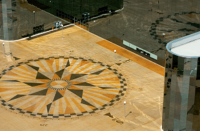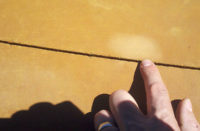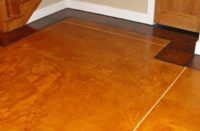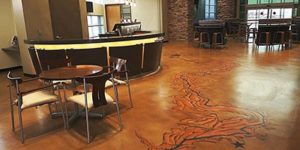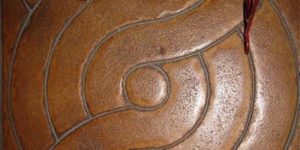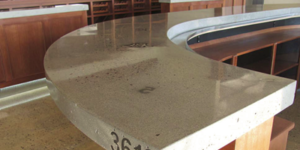
Stained concrete is a simple yet decorative upgrade for many concrete surfaces. As a decorative concrete contractor, it’s beneficial to be well-versed in concrete staining. Although it may seem simple, there are a few factors you should keep in mind to help ensure your success: finish, location and desired aesthetic.
First the finish
Stained concrete works on almost every concrete finish. You can stain concrete that’s troweled, broomed, exposed aggregate, polished, overlaid, old, new, vertical or horizontal— the options for adding color are very versatile. However, stains penetrate some finishes better than others.
When you stain or dye polished concrete, it should be applied during the polishing process so the color locks into the concrete finish instead of just resting on the surface. (We’ve all seen those quick-serve restaurants with stained concrete floors and a distracting traffic pattern worn through the stain.)
Exposed aggregate finishes can be stained as well. However, keep in mind that you’re staining the cement— not the aggregates— so the color will only tint the matrix. The original aggregate color will remain fairly intact.

Location matters
Whereas stains can be applied to virtually any concrete finish, they are not always the best choice.
For interior floors, determine foot traffic usage and wear and tear to help guide the finish selection. If it is a high-traffic area, polished concrete may be the best route. However, low-traffic areas could be fine with a topping or a grind, stain and seal.
Grind, stain and seal can also be used in a higher-traffic setting, however, maintenance requirements should be communicated upfront to clients to help ensure the floors’ good looks will last. For example, I usually recommend polished concrete with stain for school halls or a restaurant. On the other hand, I recommend stained and sealed for an office or low-traffic lobby.
For exterior concrete staining, key considerations also include traffic, as well as UV and weather exposure. Some dyes are not UV stable and shouldn’t be used outside at all. Others may last a few years under certain conditions. Always research the product to ensure it can withstand the elements it will face.
For exterior staining, reactive stains — also called acid stains — tend to work best, and they will last the longest on exposed sand or aggregate finishes and vertical faces. In an exposed sand or aggregate finish, the stain penetrates beyond the sand/aggregate at the surface and stains the cement. Therefore, the walking surface (the sand or aggregate) — not the actual stained concrete below — bears the foot traffic.
In a broom finish, the stain will walk off sooner since it doesn’t have the exposed aggregate protecting the colored portion. Also, because the color is exposed to the elements, all exterior stains will fade over time. They are not as durable as an integral color or color hardener.

Achieving desired aesthetics
When talking to your clients about stained concrete, encourage the use of photos as a reference, so you can understand precisely what they envision.
Some people may envision a lot of mottling when they think of stained concrete, while others may think of a more uniform color. By understanding their vision, you can better guide their expectations. Drastic mottling is more achievable on a floor with a cementitious topping due to a higher cement content and less aggregate exposure than it is on a polished concrete floor.
Reactive versus nonreactive stains
It’s also important to understand the difference between acid stains and dyes. Acid stains react with the concrete while dyes and other nonreactive stains tint the surface. Typically, reactive stains will penetrate deeper and last longer. However, the color palette of reactive stains is limited, and the reaction doesn’t produce consistent results.
I like reactive stains when I’m creating a more organic floor with flowing color and natural colors. Reactive stains can create great mottled effects that are harder to achieve with dyes or nonreactive stains. As with any acid, reactive stains must be neutralized after you get the desired color.
Dyes and nonreactive stains provide more color options and more reliable color outcomes since they don’t rely on a chemical reaction. If you have a client that has set expectations and has approved a mock up, dyes and nonreactive stains are the way to go.
Stains offer a cost-effective way to add colorful accents without requiring multiple pours. Stains can be the most economical way to add color to concrete, but the cost savings needs to be weighed with the other factors mentioned earlier to ensure it’s the best solution for the client. As with many finishes and options for decorating cured concrete, proper surface preparation is a crucial step as well. See Chris Sullivan’s article this month for details.
Questions from Concrete Decor
Question
We are working with a limited budget, and are having just under 1,000 sq. ft. of concrete poured around our pool. We may end up with just a brushed finish. Is an acid stain still an option with a brushed finish?
Answer
Acid staining is okay on a broomed surface. However, it will look best if the broomed finish is subtle, not aggressive.
Also make sure your concrete contractor does not apply any kind of cure-and-seal following the placement of the pool deck. You may need to water down the slab for a few weeks following the installation to keep moisture evaporation in the slab at a minimum. However, this will get you around the use of this product and ensure that your acid stain can properly react with the concrete surface. Tell your contractor what your intentions are so they know how to proceed.
Since we don’t know where you’re located, ask your contractor if he/she has any suggestions on how to get around the use of products that assist with concrete curing in summertime conditions.
